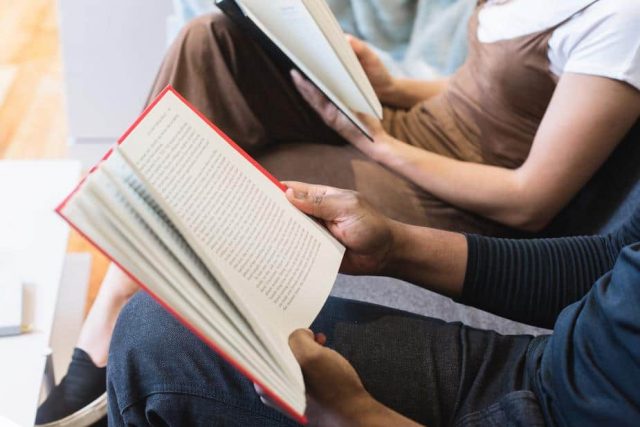Books are vehicles of reflection, understanding, and change in society; they allow readers to step into the shoes of characters whose lives are far from their own.
In light of the Black Lives Matter movement, there is no text more important to read and teach this school year than The Hate U Give; Angie Thomas’s fictional tale of Star Carter, a 16-year-old black girl torn between two worlds who witnesses the fatal shooting death of her best friend, Khalil, at the hands of a white police officer.
This novel has had a place in my classroom reading library for two school years now, but over the summer, I purchased an entire class set and will be teaching it as a novel study.
If you don’t have access to funds for a new novel set of THUG, the film version of the text is available on streaming devices. Newsweek also has an article on how to watch the movie for free.
Regardless of your medium of textual study, check out the following easy peasy reading activities to support your instruction and analysis of the THUG. Really, if all we do as educators is get kids to read and talk about this book (or movie), it’s one step in the right direction.
Pre-Reading Activities
1. Free Write
Students are given the following passage from the jacket of the novel, then are asked to record their thoughts about it in writing throughout a structured period (5–10 minutes).
“Sixteen-year-old Starr Carter moves between two worlds: the poor black neighborhood where she lives and the fancy suburban prep school she attends. The uneasy balance between these worlds is shattered when Starr witnesses the fatal shooting of her childhood best friend, Khalil, at the hands of a police officer. Khalil was unarmed.”
Purpose: To create interest and introduce readers to the central conflict, themes, and protagonists of the text. Also, to provide a writing diagnostic.

2. Google Form Survey
The teacher creates a Google Form survey with questions about student thoughts, feelings and knowledge of the BLM movement and the text/movie, THUG. The survey should be anonymous. The teacher then shows the results in class as a starting point for conversations about BLM, and the text, THUG.
Purpose: To gauge understanding and knowledge of BLM movement and current issues, and provide a reading self-diagnostic/reflection.
3. Article Analysis
Students are given an article or series of articles on the topic of high profile police shootings of black people. They are asked to actively read the articles, then share thoughts and reactions to them through a teacher structured forum (Padlet, group discussion, written reflection).
Purpose: To introduce students to the origins of the BLM movement, while creating a base for textual connections with THUG.
During Reading Activities
4. Double Entry Journal
Students are either given a blank double entry journal chart OR are asked to create one in their notebooks.

The first column will be a place for the student to record (or teacher to populate) important passages from the text. referring to a variety of literary elements: theme, plot, characterization, setting, conflict as well as textual connections (self, text, world).
The second column to the right of the passages column is a place for students to record their thoughts/observations/reactions to the given passage.
*passages are expected to be recorded using quotation marks and MLA citation style*
Purpose: To allow students to make textual as well as literary and style connections to the text throughout the reading process. To help students practise MLA citation. Also, to provide formative evidence of comprehension for assessment purposes.
5. Reader’s Notebook
Students are given a blank notebook, and are asked to record a reflective entry after each reading period which could note any/all of the following:
- number of pages read in the reading period
- thoughts, observations, reflections of the section read
- creative illustrations of elements of the text
- textual connections (self, text, world)
- questions about the text, style, etc.
- inferences about what will happen next
- literary observations of plot, characters, theme, setting, etc.
*Reader’s Notebooks are often used in conjunction with small group book clubs and offer a ‘jumping off’ point for group discussions*
Purpose: To allow students to make textual as well as literary and style connections to the text throughout the reading process. To encourage creativity and thought. In addition, to provide formative evidence of comprehension for assessment purposes.
6. Small Group Book Clubs
Students are organized in small groups (no more than 4 students), preferably based on social connections to allow students to feel comfortable speaking and sharing ideas.
The group meets on a daily or bi-daily basis throughout the reading of the text, THUG, and engages in conversations about the text either guided by their Reader’s Notebook entries and/or teacher prompts.
The teacher circulates and takes part in conversations with each group for a short period of time to gauge comprehension and encourage authentic, relevant textual conversation.
Purpose: To allow students to make textual as well as literary and style connections to the text throughout the reading process. To help them practise oral communication skills. Finally, to provide formative evidence of comprehension for assessment purposes.

Post-Reading Activities
7. Digital Storytelling
Students are asked to work in small groups, and to select a ‘critical’ scene from THUG to recreate through a ‘digital story’ using WeVideo or a similar digital movie creation site.
Upon presentation of their scene to the class, they are asked to provide a preamble of its importance to the text as a whole, as well as why it was selected as a reenactment.
Purpose: Assessment of textual comprehension, visual media skills, and oral communication skills.
8. Personal or Literary Essay
Students are asked to reflect on their Double Entry Journal or Reader’s Notebook, then to work with their teacher on deriving a thesis direction for a literary or personal essay.
The goal is to focus on threads of learning already developed in the ‘during reading’ process of study.
Once a thesis is agreed upon, the student would move forward with the writing process.
Purpose: Assessment of textual comprehension and referencing, and assessment of writing and MLA citation skills.
9. Hot Topic Persuasive Speech
Teachers provide textual passages or generalized “hot topics” regarding the novel or topic of BLM. Students are asked to take ONE side of the issue and prepare a persuasive speech on the topic, using both textual support and independent research if applicable.
For speech delivery, the teacher organizes students based on the topic they chose, then for each “hot topic” the audience votes on the most persuasive point of view.
Purpose: Assessment of textual comprehension and referencing, and assessment of oral communication skills.
10. Mock Trial
The teacher works with students to create a ‘mock trial’ for officer Brian Cruise Jr., selecting a team of lawyers for each side of the case, witnesses and jurors.
All stakeholders must prepare their parts using textual research and role play based on their knowledge of the plot, characters, etc.
Purpose: Assessment of textual comprehension and referencing, and assessment of oral communication skills.
Useful Resources
- Guided reading activities
- Kindergarten reading activities
- Reading activities for preschoolers
- Reading activities for comprehension
- Fun reading activities
- Pre reading activities
- Fluency in reading activities
- Middle School reading activities
- Reading activities for kids
- Reading activities for High School
- Reading activities for ESL
- Interactive reading activities
- Reading activities online
- Reading activities at home
- Hands on reading activities
- Reading activities for adults

